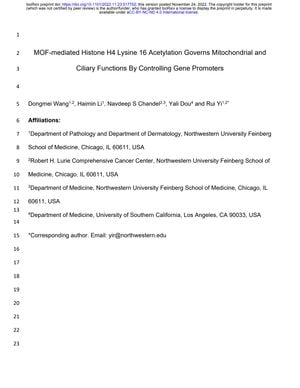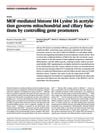MOF-Mediated Histone H4 Lysine 16 Acetylation Governs Mitochondrial and Ciliary Functions by Controlling Gene Promoters
November 2022
in “
bioRxiv (Cold Spring Harbor Laboratory)
”

TLDR MOF controls skin development by regulating genes for mitochondria and cilia.
The study investigates the role of MOF-mediated histone H4 lysine 16 acetylation (H4K16ac) in mammalian skin development. Conditional deletion of Mof, but not Kansl1, leads to severe defects in murine skin, including failure of basal epithelial progenitors to establish the basement membrane and cell polarity, resulting in compromised self-renewal, epidermal differentiation, and hair growth, ultimately causing barrier defects and perinatal lethality. MOF-regulated genes are enriched in mitochondrial and ciliary functions, coordinated with the RFX2 transcription factor. Deletion of Uqcrq, a key subunit of ETC Complex III, mimics the defects seen in MOF cKO, highlighting the critical role of the MOF/ETC axis in skin development.


